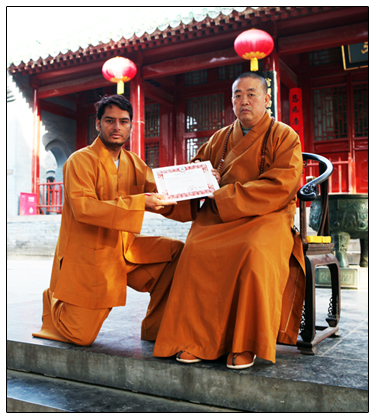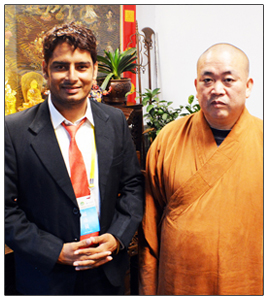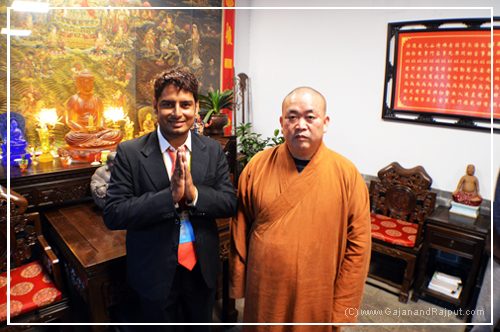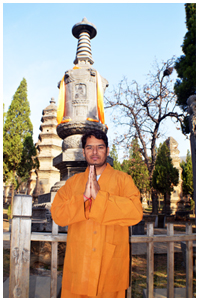GAJANAND RAJPUT AT THE MAIN ENTRANCE GATE OF THE SHAOLIN TEMPLE
Song Shan Shaolin Temple
Dengfeng City,
Henan Province, China
The Shaolin Temple "Monastery"Shaolin Temple was founded when an Indian monk named Ba Tuo came to China. At that time, China was divided into two kingdoms separated by the Yantse River. Ba Tuo went to the northern kingdom and asked Emperor Shao Wen for some secluded land where he could found a Buddhist monastery. Ba Tuo went to the Song mountain range in Henan Province and took some land in a forest at the foot of Shao Mountain. In Madarin, "lin" means forest; the monastery got its name by combining "Shao" and "lin".
Ba Tuo's lineage ended 32 years later. His philosophy of Xiao Xing Buddhism was not continued, because it did not give his followers the correct tools to adapt the philosophy to their needs. However, Ba Tuo did make disciples of two former generals, Hui Guang and Seng Chou. These warriors brought the first martial arts to Shaolin Temple. This was a good thing, because the monastery soon proved to be an irresistible target for local bandits and thieves. Beginning with Hui Guang and Seng Chou, the monks learned how to defend themselves, and thus the tradition of the Shaolin warrior monk was born.
Because Shaolin Temple is revered around the world as the home of martial arts, there is a common misperception that the practice of kung fu began there. In fact, various martial arts were already thousands of years old when the temple was founded. However, it was at Shaolin Temple that they were combined and systematized.
Ba Tuo's successor as abbot of Shaolin Temple also came from India. Buddhidama, who became known in China as Da Mo, was another prince who renounced his worldly riches and power to pursue a spiritual path. In AD 527, Da Mo went to a cave on one of the five Breast Mountains behind Shaolin Temple, sat down, and began meditating. Da Mo sat facing a wall in the cave and meditated for 9 years.






The Training Base of Warrior Monks Group of China's Songshan Shaolin Templeis a large-sized training base in the Shaolin Temple, which is in charge of external teaching, performance, visit, inheriting and spreading Shaolin culture of Chan Buddhism (Zen) and Shaolin Kungfu, and cultivating successors for the Shaolin Temple. Its members are mainly composed of Shaolin's warrior monks and layman disciples. The teaching tenet of the Base is to cultivate them in an all round way and train them hard and strictly so as to make them have culture and kungfu, good virtues and excellent skills. In order to meet the demands of kungfu lovers from all the corners studying in the Shaolin Temple, the new campus, under the careful plan and direction of Abbot Shi Yong Xin, and under the joint efforts of the General Kungfu Drillmaster Shi Yan Lu and the whole staffs, has taken its shape considerably. With the land area of over 500 mu, planned construction area more than 200 thousand sqaure meters, greening area 25 thousand square meters and total investment about RMB 350 million Yuan, and more than 4000 teachers and students, it has been built into a new international-level comprehensive martial arts college, characterized with Shaolin Kungfu, gathering martial arts, movie, television, art, traditional culture and modern science and technology as a whole. Higher courses are taught here. It must be the center where a person with lofty ideals live, study, research, communicate and develop shaolin culture of Chan Buddhism (Zen) and Shaolin Kungfu, which will make a greater contribution to inheriting and promoting the development of advanced culture in the world.






Grand Master Shi Yong Xin
"30th Abbot of Shaolin Temple"
Grand Master Shi Yong Xin was born in 1965 in Yingshang, Anhui province, with the birth name Liu Yingcheng. Now he is the vice director of China Buddhist Association, director of Hanan Branch. He is also the representative of the ninth, tenth National Congress of the Communist Party of China, 30th Abbot of Shaolin Temple and the director of the Training Base of Warrior Monks Group of China's Songshan Shaolin Temple. Grand Master Shi Yong Xin inherits the tradition and makes innovations in a pioneering spirit. Handlingthe affairs of the temple, he is diligent in writing his works. In recent years, his monograph The Chan Collection has been published, besides, he has edited the Secret Book of Medicine Sect Kungfu of the Shaolin Temple, Shaolin Kungfu Collected Works and the Study Articles Collection of International Chan Culture by himself or with others. He has founded Shaolin School of Thought to carry on the domestic and overseas cultural exchange, declared Shaolin Kungfu as the non-material cultural heritage and made a great contribution to spreading Shaolin culture of Chan Buddhism (Zen) and Shaolin Kungfu.

Master Shi Yan Lu
"34th Generation Shaolin Monk" - Second Superior Abbot of Shaolin Temple
As the general drillmaster of Shaolin's warrior monks, he was born in 1970 in Tancheng, Shandong province, with the birth name Lin Qinghua. He came from a well-known martial arts family, and became a monk in 1985 under Abbot Shi Yong Xin to cultivate himself according to doctrine of the Chan sect and study martial arts. Under the careful teaching of Abbot Shi Yong Xin, he quickly became an excellent warrior monks who has known well both Shaolin culture of Chan Buddhism (Zen) and Shaolin Kungfu, especially good at such unique Kungfu skills as Wuxing boxing, Dahong boxing, hawk-paw boxing, Shaolin chunqiu broadsword, iron coat skill, and etc. He participated in digging up and sorting up Kungfu Secret Book of China's Shaolin Temple, Shaolin Kungfu Collected Works and was invited to perform and teach Shaolin Kungfu in several decades of countries or areas. In 1988, he won the championship in the World Martial Arts Meeting held in Toronto of Canada. At the same time, he set up the Training Base of the Warrior Monks Group of China's Songshan Shaolin Temple, which cultivated a great number of Shaolin Kungfu talents. In April 2003, he and the Abbot successfully held the international academic discussion of Shaolin Kungfu. And in 2003, his Shifu officially named him Master instructor of the Warrior Monks of Shaolin (Wu Seng), the highest recognition for a monk in Shaolin. In 2004,he set up overseas divisions of the Training Base in many countries such as America, Russia, France, Germany and so on. Master Shi Yan Lu is a very respected monk in the Temple. He is the number two manager at the Monastery. When Grand Master Shi Yong Xin (Superior Abbot of the Temple) is away, he is the one in charge.
Master Gajanand Rajput "Shi Heng Chang"
"35th Generation Shaolin Temple Warrior Secular Disciple"
Master Gajanand Rajput is the founder and chief instructor of Central Wushu KungFu Guan, Secretary General of Wu-Shu KungFu Federation of India. On November 25th, 2006, he is officially accepted as the "35th Generation Shaolin Temple Warrior Secular Disciple" by Master Shi Yan Lu. The Buddhist ceremony was held at the Shaolin Monastary. During the ceremony, Master Gajanand Rajput received his official Shaolin Monk name "Shi Heng Chang ".




Training at the Shaolin Monastery
Master Gajanand Rajput had an opportunity to trained in Shaolin Kungfu under Master Shi Xing Wang. Master Shi Xing Wang has been training in Shaolin Kungfu for more than 30 years. He is also the head coach of the fighting monks of Fa Wang Temple. Currently, Master Shi Xing Wang is in charge of training foreign students.











Buddhidama's Cave
Master Gajanand Rajput and his student, Doctor Basumatary visited the Buddhidama's Cave. The road to Buddhidama's Cave is 4000 m and would takes about 60 minutes walk to reach to the summit of Mt. Song Shan.
In the 6th century, Buddhidama (also know as Da Mo), an Indian prince on a pilgrimage from India crossed the Himilayan mountains on foot and eventually arrived in China. He attempted to take up residence in the Shaolin Temple, where he was not well received by the head abbot. At this point, Buddhidama took refuge in a cave high atop nearby Song Mountain where he meditated for the next nine years. As the legend goes, several years of his meditation, Buddhidama fell asleep. He was so disgusted with himself that he cut off his own eyelids and threw them away, vowing to never fall asleep during his meditations again. Hence the reason that all depictions of Buddhidama show him with wide and wild eyes. At the conclusion of his meditation, the abbot repented and allowed Buddhidama entrance to the temple.
What Buddhidama found in the temple shocked him. The monks were in an emaciated state from only studying and praying all day. They were too frail and weak to stay awake during his rigorous meditation sessions. In order to build their strength and health, Buddhidama developed a series of 49 exercises, which became known as I Chin Ching, the Change of the Muscle, Bone, and Senew. These exercises are similar to modern day yoga and would become the foundation for Shaolin martial arts.
The monks hated Buddhidama and his exercises. Every morning they would hide from him and he would have to find them and drag them into the courtyard to practice, beating them with a stick, if necessary. And then one morning, Buddhidama couldn't find the monks. They were not in any of their usual hiding spots. He looked everywhere before proceeding to the courtyard to practice himself, where he found all of them waiting. They had undergone a transformation, both physically and mentally. They had seen the benefits of getting in shape and had started to like it.


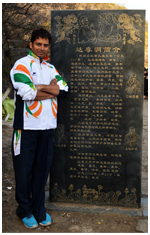
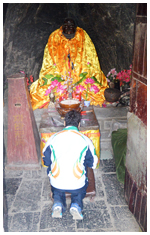
The Pagoda Forest
Master Gajanand Rajput and his student, Uttam Narzary Coach, Doctor Basumatary and Udansri Narzary visited the Pagoda Forest.
The Pagoda Forest is about 500 meters west of the Changzhu Yard, is the cemetery of monks of all generations of Shaolin Temple. Dignitary monks of the Shaolin Temple were buried here with a pagoda established on the top of the tomb to show their merits and virtues. Composed of more than 240 brick or stone pagodas built in the Tang, Song, Jin, Yuan, Ming and Qing Dynasties, the Pagoda Forest is the largest ancient pagoda group in China. The height, size, shape and the floor numbers of pagodas vary from monk to monk, based on their Buddhist status, cultivation, the number of his followers and the financial condition of the temple in a certain period. Pagodas here have one to seven floors, 15 meters being the maximum in height, often with inscriptions. Various in shapes from squares to hexagons, from columns to cones; different in materials and structures from a whole stone to layers of bricks, they are peculiar with great diversification, making an art museum of ancient pagodas.



Dengfeng City
Master Gajanand and his student, Doctor, Udangsri, Uttam and Balraj visited Dengfeng City, about 15 minutes drive from the Shaolin Temple.
Dengfeng lies between Zhengzhou and Luoyang, bounded on the north by Gongyi city and on the south by Ruzhou city. It has a total area of 1220 square kilometers and the population of 600,000. It has 7 counties, 7 towns, 2 iundustrial zones and 1 office under its jurisdiction. It is a high-developed, civilied, hygienic and modern city.




| Copyright © gajanandrajput.com |

